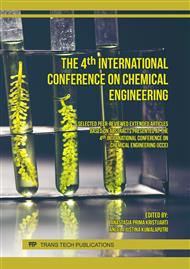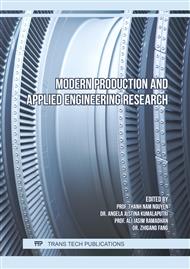[1]
E. Hambali and M. Rivai, "The Potential of Palm Oil Waste Biomass in Indonesia in 2020 and 2030," IOP Conf. Ser. Earth Environ. Sci., vol. 65, p.2–7, 2017.
DOI: 10.1088/1755-1315/65/1/012050
Google Scholar
[2]
E. Hermiati, D. Mangunwidjaja, T. C. Sunarti, and O. Suparno, "Pemanfaatan Biomassa Lignoselulosa Ampas Tebu Untuk Produksi Bioetanol," J. Penelit. dan Pengemb. Pertan., vol. 29, p.123, 2010.
Google Scholar
[3]
G. Marcotullio, M. A. T. Cardoso, W. De Jong, and A. H. M. Verkooijen, "Bioenergy II: Furfural destruction kinetics during sulphuric acid-catalyzed production from biomass," Int. J. Chem. React. Eng., vol. 7, p.7, 2009.
DOI: 10.2202/1542-6580.1980
Google Scholar
[4]
B. Girisuta, "Levulinic Acid from Lignocellulosic Biomass," University Gronigen. p.8, 2007, [Online]. Available: http://dx.doi.org/10.1016/j.jiec.2011.02.025%5Cn
Google Scholar
[5]
A. P. Dunlop, "Furfural Formation and Behavior," Ind. Eng. Chem., vol. Vol 40, p.204, 1948.
Google Scholar
[6]
K. Kohli, R. Prajapati, and B. K. Sharma, "Bio-Based Chemicals From Renewable Biomass For Integrated Biorefineries," Energies, p.4–5, 2019.
DOI: 10.3390/en12020233
Google Scholar
[7]
X. Hu, R. J. M. Westerhof, D. Dong, L. Wu, and C. Z. Li, "Acid Catalyzed Conversion of Xylose in 20 solvents: Insight into interactions of The Solvents With Xylose, Furfural, and The Acid Catalyst," ACS Sustain. Chem. Eng., p. A-E, 2014.
DOI: 10.1021/sc5004659
Google Scholar
[8]
O. Ershova, J. Kanervo, S. Hellsten, and H. Sixta, "The Role Of Xylulose as an Intermediate In Xylose Conversion To Furfural: Insights Via Experiments And Kinetic Modelling," RSC Adv., p.66727–66732, 2015.
DOI: 10.1039/c5ra10855a
Google Scholar
[9]
A. S. Dias, M. Pillinger, and A. A. Valente, "Dehydration of Xylose Into Furfural Over Micro-Mesoporous Sulfonic Acid Catalysts," J. Catal., p.419–421, 2005.
DOI: 10.1016/j.jcat.2004.11.016
Google Scholar
[10]
M. A. Mellmer, C. Sener, J. M. R. Gallo, J. S. Luterbacher, D. M. Alonso, and J. A. Dumesic, "Solvent Effects in Acid-Catalyzed Biomass Conversion Reactions," Angew. Chemie - Int. Ed., p.11872–11875, 2014.
DOI: 10.1002/anie.201408359
Google Scholar
[11]
J. Iglesias, J. A. Melero, G. Morales, M. Paniagua, and B. Hernández, "Dehydration of Xylose to Furfural in Alcohol Media in the Presence of Solid Acid Catalysts," ChemCatChem, vol. 8, no. 12, p.2089–2099, 2016.
DOI: 10.1002/cctc.201600292
Google Scholar
[12]
G. Marcotullio and W. De Jong, "Furfural formation from D-xylose: The use of different halides in dilute aqueous acidic solutions allows for exceptionally high yields," Carbohydr. Res., vol. 346, no. 11, p.1291–1293, 2011.
DOI: 10.1016/j.carres.2011.04.036
Google Scholar
[13]
G. Marcotullio and W. De Jong, Chloride Ions Enhance Furfural Formation From D-xylose In Dilute Aqueous Acidic Solutions, vol. 12. The Royal Society of Chemistry, 2010.
DOI: 10.1039/b927424c
Google Scholar
[14]
J. N. M. Tan-soetedjo, "Biobased Furanics From Sugars." Netherlands, p.126–136, 2017.
Google Scholar
[15]
J. Köchermann, J. Schreiber, and M. Klemm, "Conversion of D -xylose and hemicellulose in water / ethanol mixtures," ACS Sustain. Chem. Eng., p.14, 2019.
DOI: 10.1021/acssuschemeng.9b01697
Google Scholar
[16]
A. Yamaguchi, O. Sato, N. Mimura, Y. Masuda, and M. Shirai, "Effect of extraction on furfural production by solid acid-catalyzed xylose dehydration in water," J. Supercrit. Fluids, vol. 144, p.14–18, 2018.
DOI: 10.1016/j.supflu.2018.10.004
Google Scholar
[17]
M. Paniagua, S. Saravanamurugan, M. Melian-Rodriguez, J. A. Melero, and A. Riisager, "Xylose isomerization with zeolites in a two-step alcohol-water process," ChemSusChem, vol. 8, no. 6, p.1088–1094, 2015.
DOI: 10.1002/cssc.201402965
Google Scholar
[18]
T. L. K. Yong, N. Mohamad, and N. N. M. Yusof, "Furfural Production from Oil Palm Biomass Using a Biomass-derived Supercritical Ethanol Solvent and Formic Acid Catalyst," Procedia Eng., vol. 148, p.395–398, 2016.
DOI: 10.1016/j.proeng.2016.06.495
Google Scholar
[19]
G. Solomons, C. Fryhle, and S. Snyder, Organic Chemistry, vol. 11 E, no. 1. 2014.
Google Scholar



